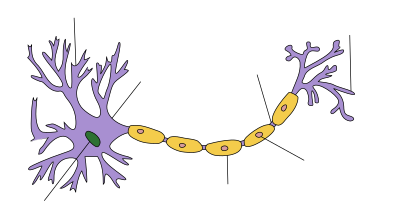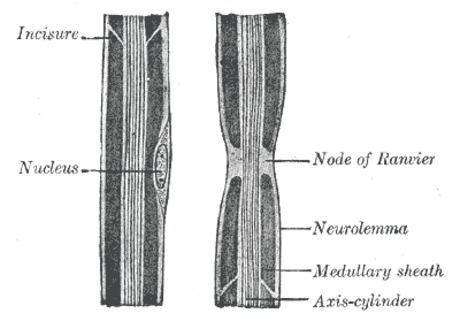兰氏结(英语:Nodes of Ranvier)又名郎飞结,郎飞氏结。是神经元的一部分,以首位描述该结构的法国科学家路易斯·安托万·兰维尔为名[1]。
Quick Facts 兰氏结, 基本信息 ...
Close
神经元的髓鞘包覆着轴突,兰氏结是神经元上每隔数毫米就会出现的没有髓鞘的部分。
跳跃传导学说认为,因为在兰氏结之间的结间区的电阻极高,而在结区的电阻极低,并且轴突膜仅在结区可接触细胞外液,所以,局部电流必须在兰氏结处穿出膜在髓鞘处形成回路,进行跳跃式传导[2]。
虾的内侧大纤维没有兰氏结[3]。
- 结间段(节间段、结间体)
- 施旺细胞
- 少突神经胶质细胞(少突胶质细胞、寡突胶细胞、寡突细胞、少突细胞、稀少突起阿胶细胞、稀突起胶细胞)
- 髓磷脂
R. Douglas Fields,〈大脑白质有价值〉,《科学人》第74期2008年4月号,第44-54页,2009-4-20查阅
- Baumann, Nicole; Pham-Dinh, Danielle. Biology of Oligodendrocyte and Myelin in the Mammalian Central Nervous System. Physiological Reviews. 2001, 81 (2): 871–927 [2007-07-13]. PMID 11274346. (原始内容存档于2007-05-26).
- Ragheb, Fadi. The M3 Muscarinic Acetylcholine Receptor Mediates p42mapk Activation and c-fos mRNA Expression in Oligodendrocyte Progenitors (PDF). Ottawa: National Library of Canada. 1999 [2006-03-07]. (原始内容存档 (PDF)于2006-05-16).
- Raine, C.S. (1991). Oligodendrocytes and central nervous system myelin. In Textbook of Neuropathology, second edition, R.L. Davis and D.M. Robertson, eds. (Baltimore, Maryland: Williams and Wilkins), pp. 115–141.
- Tkachev D, Mimmack ML, Ryan MM, et al. Oligodendrocyte dysfunction in schizophrenia and bipolar disorder. Lancet. September 2003, 362 (9386): 798–805. PMID 13678875. doi:10.1016/S0140-6736(03)14289-4.
- Káradóttir, R.; D. Attwell. Neurotransmiter receptors in the life and death of oligodendrocytes. Neuroscience. 14 April 2007, 145 (4): 1426–1438. PMC 2173944
 . PMID 17049173. doi:10.1016/j.neuroscience.2006.08.070.
. PMID 17049173. doi:10.1016/j.neuroscience.2006.08.070.
- Carlson, Neil. Physiology of Behavior. Boston, MA: Allyn & Bacon. 2010: 38–39. ISBN 0-205-66627-2.
- Sokol, Stacey. The Physiology and Pathophysiology of Multiple Sclerosis. Multiple Sclerosis: Physiological Tutorial. [2012-04-29]. (原始内容存档于2012-07-16).
- Fields, Douglas. White Matter Matters. Scientific American. 18 February 2008, 298 (March 2008): 54–61 [2012-04-29]. Bibcode:2008SciAm.298c..54D. doi:10.1038/scientificamerican0308-54. (原始内容存档于2013-11-01).
- Menn, Benedicte; Oscar Gonzalez-Perez. Origin of Oligodendrocytes in the Subventricular Zone of the Adult Brain. The Journal of Neuroscience. 26 July 2006, 26 (30): 7907–7918 [2012-04-29]. PMID 16870736. doi:10.1523/JNEUROSCI.1299-06.2006. (原始内容存档于2019-12-07).
- Gonzalez-Perez, O, B; Romero-Rodriguez, R; Soriano-Navarro, M; Garcia-Verdugo, JM; Alvarez-Buylla, A. Epidermal growth factor induces the progeny of subventricular zone type B cells to migrate and differentiate into oligodendrocytes.. Stem Cells. 2009, 27 (8): 2032–43. PMC 3346259
 . PMID 19544429. doi:10.1002/stem.119.
. PMID 19544429. doi:10.1002/stem.119.
- Vallstedt, A; Klos JM; Ericson F. Multiple dorsoventral origins of oligodendrocyte generation in the spinal cord and hindbrain. Neuron. 1. 6 January 2005, 45 (1): 55–67. PMID 15629702. doi:10.1016/j.neuron.2004.12.026.
- Thomas, JL; Spassky N; Perez Villegas EM; Olivier C; Cobos I; Goujet-Zalc C; Martínez S; Zalc B. Spatiotemporal development of oligodendrocytes in the embryonic brain. Journal of Neuroscience Research. 15 February 2000, 59 (4): 471–476. PMID 10679785. doi:10.1002/(SICI)1097-4547(20000215)59:4<471::AID-JNR1>3.0.CO;2-3.
- Richardson, WD; Kessaris, N; Pringle, N. Oligodendrocyte wars. Nature Reviews Neuroscience. 1. 2006, 7 (1): 11–18. PMID 16371946. doi:10.1038/nrn1826.





